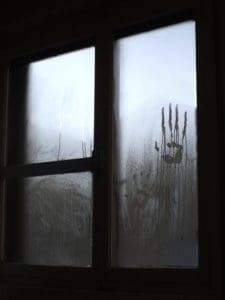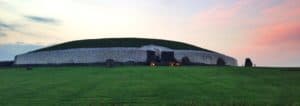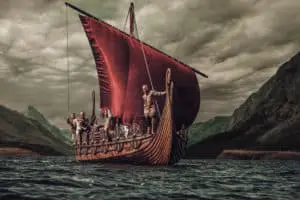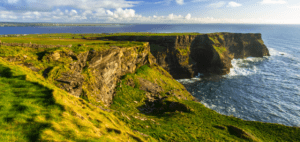The Giants of Myth: Exploring Ireland’s Fomorians and Greece’s Titans
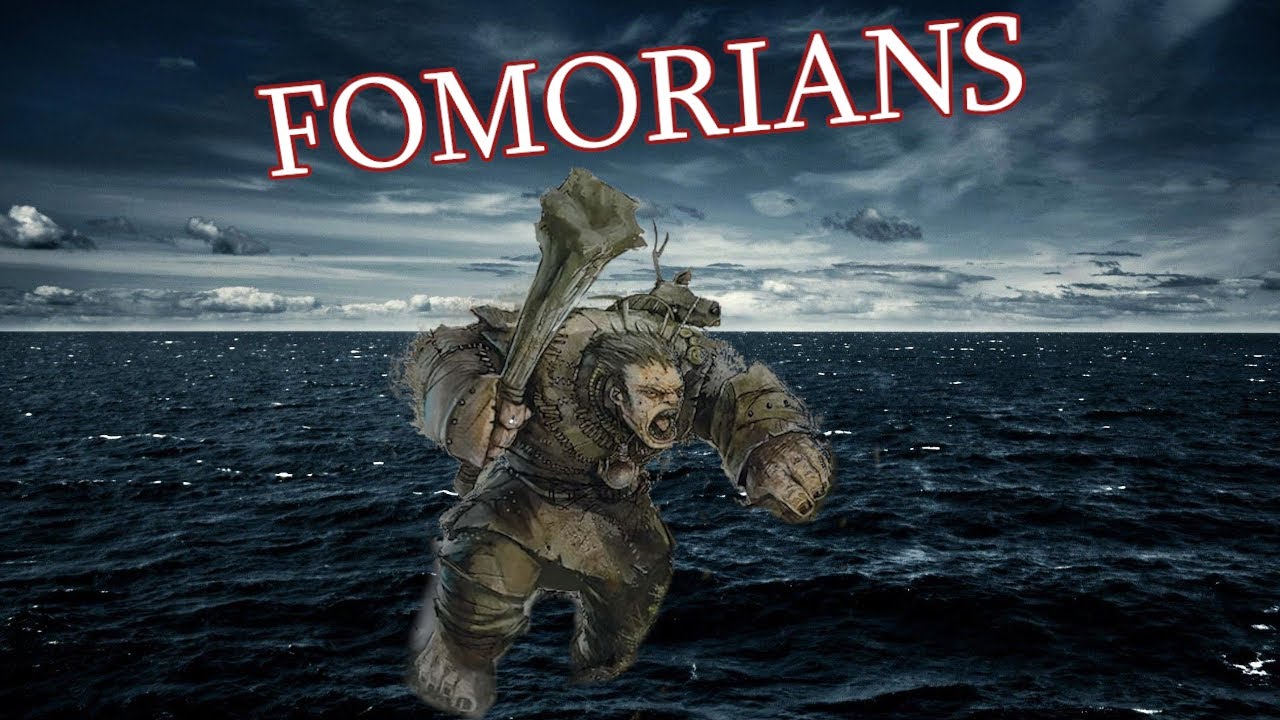
Updated On: April 20, 2024 by Eman Sameh
Throughout history, mythologies across the world have revered and feared formidable beings known as giants. In different cultures, these colossal entities play central roles in the unfolding narratives of gods, the earth, and the cosmos. Amongst Ireland’s ancient tales, the Fomorians emerge as enigmatic titans, shrouded in mystery and often depicted with hostility and monstrosity. These mythic beings believed to dwell beneath the seas or within the hidden recesses of the earth, are said to have arrived in Ireland long before the coming of the Celts.
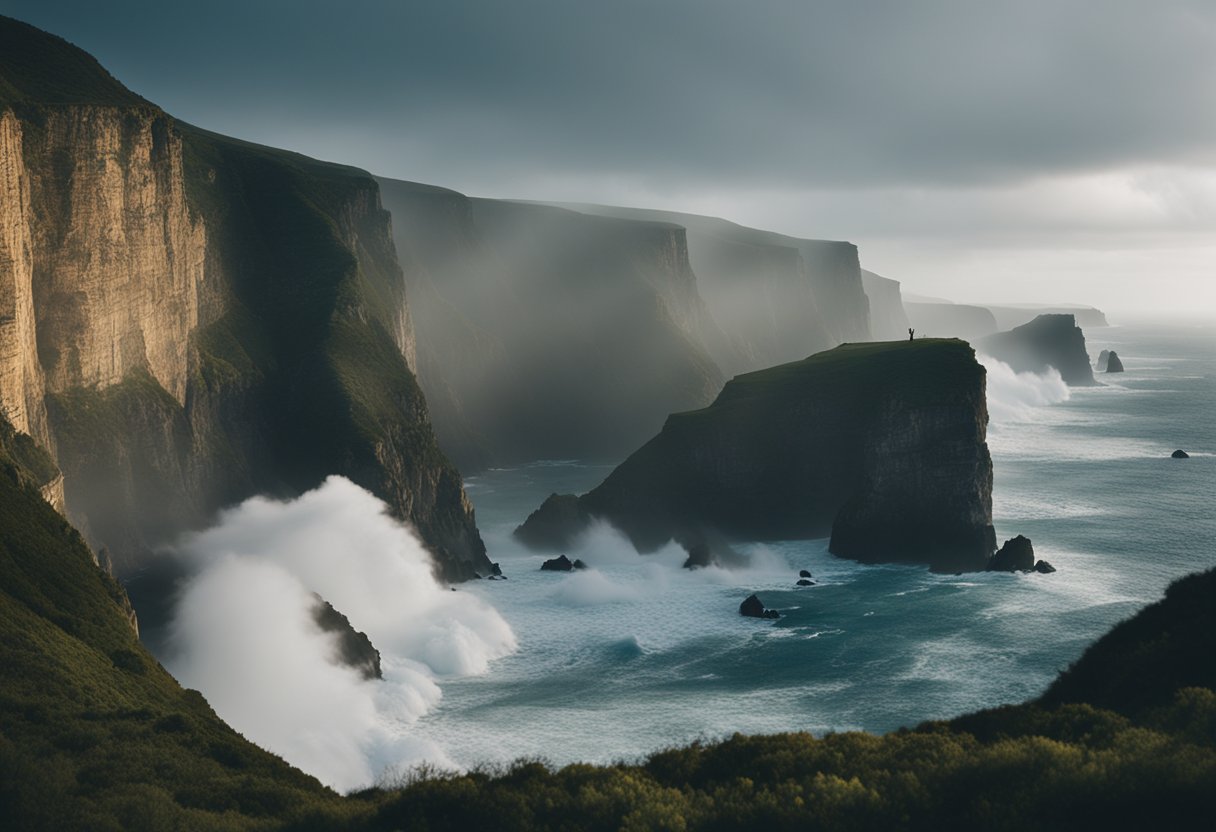
Our fascination with these legends extends to the pantheons of ancient Greece, where the Titans hold an equally significant place. Predating the Olympian gods, the Titans are the towering predecessors who shaped the universe only to be overthrown in a cataclysmic clash of divine wills. Their stories, interwoven with themes of power, rebellion, and destiny, have captured imaginations for centuries.
The Myth and Its Roots
In exploring the vast tapestries of myth and folklore, we trace the echoes of ancient giants through the stories passed down through generations. These tales reveal more than just fantastical beings—they are a window into the cultures that created them.
The Essence of Myth and Folklore
Myth and folklore form a cornerstone of cultural heritage, offering insights into the values, fears, and aspirations of our ancestors. The presence of giants in these tales is a common thread seen across various traditions. In Irish folklore, the Fomorians were known as a malevolent race of giants, often depicted with monstrous features and incredible strength. This imagery captures not only the imagination but also the essence of the challenges faced by people in their daily lives.
Genesis of Giants in Mythology
Giants in mythology often represent the forces of nature and the universe’s inexplicable power. The creation myths in which these giants frequently appear serve to explain the unexplainable, providing narratives that have shaped our understanding of the world. For instance, the Titans of Greek mythology personify primal concepts and natural phenomena, each embodying elements like the sun, the moon, or the ocean that were beyond ancient people’s control or comprehension.
Cultural Impact of Mythological Giants
The giants of myth have left a significant mark on our cultural consciousness, contributing to a rich tapestry of collective stories and experiences. They’ve been subject to varied interpretations, from the Fomorians, seen by some as invaders and by others as ancient gods of chaos and wild nature, to the Titans, who were overthrown by the Olympian gods in a tale of rebellion and order. The way these giants have woven themselves into the fabric of our cultural identity is a testament to their enduring influence.
Delving into the world of giants provides not only entertainment but also a profound connection to the history that has forged our current understanding. Giants in mythology are a powerful reminder of nature’s enormity, the endless cycle of creation and destruction, and the ever-present human desire to personify and comprehend our surroundings.
The Fomorians: Ireland’s Enigmatic Titans
The Fomorians, akin to destructive giants and considered one of the earliest beings in Irish mythology, played a crucial role in shaping the country’s mythological history.
Characteristics of the Fomorians
The Fomorians are often depicted as monstrous and grotesque, with varying descriptions suggesting they had the power to control natural phenomena, especially the more chaotic aspects. Some texts describe them with distorted forms, such as having the body of a man and the head of a goat or a single eye, one arm, and one leg, underscoring their otherworldly nature.
Important Fomorians: Balor and Lugh
Two figures stand out in the myths: Balor, known for his destructive eye that wrought havoc, and Lugh, a figure of the opposition, the Tuatha Dé Danann, who had ties to the Fomorians through his grandfather. The intersection of these two characters symbolises the overlapping and complex nature of Irish lore, where kinship and enmity intertwine.
The Battles of Mag Tuired
The Fomorians’ significance is especially highlighted in the Battles of Mag Tuired, which were pivotal in the mythological narrative. These battles illustrate the clash between the Fomorians and the Tuatha Dé Danann, with the first battle leading to the Fomorians’ dominance over Ireland and the second resulting in their defeat, signifying the changing of an era in Irish myth.
Tuatha Dé Danann: The Divine Tribe
In our exploration of Celtic mythology, one cannot overlook the Tuatha Dé Danann, regarded as divine beings with extraordinary skills in arts and magic, influencing the pantheon and culture of the Celts.
The Dana: Gods or Mortals?
The Tuatha Dé Danann, or the “people of the goddess Dana”, straddle the line between divinity and mortality. According to Irish mythology, they were a race of god-like beings possessing great power and wisdom who arrived in Ireland shrouded in mystery. Their legacy suggests that they were neither entirely gods nor mortal; they were revered ancestors with supernatural abilities.
The Druidic Pantheon
Within this Druidic Pantheon, figures like the Dagda, Morrigan, and Brigit held significant roles. The Dagda, known as the ‘good god’, was celebrated for his prowess as a leader and father figure. Morrigan, embodying war and fate, is captivated by her complex nature. Brigit, the goddess of healing, poetry, and smithcraft, was vastly honoured for her manifold skills. These deities profoundly shaped the spiritual lives of the ancient Celts.
Celtic Mythos: Tuatha Dé Danann’s Role
The Tuatha Dé Danann’s influence on Celtic mythos is undeniable. They are central characters in the tales that compose the fabric of ancient Irish lore. Their battles, like those against the oppressive Fomorians, and their eventual succumbing to the Milesians, reflect the ever-evolving nature of power and society, leaving behind a treasure trove of stories and beliefs that continue to intrigue us.
From Greek Olympus to Norse Asgard
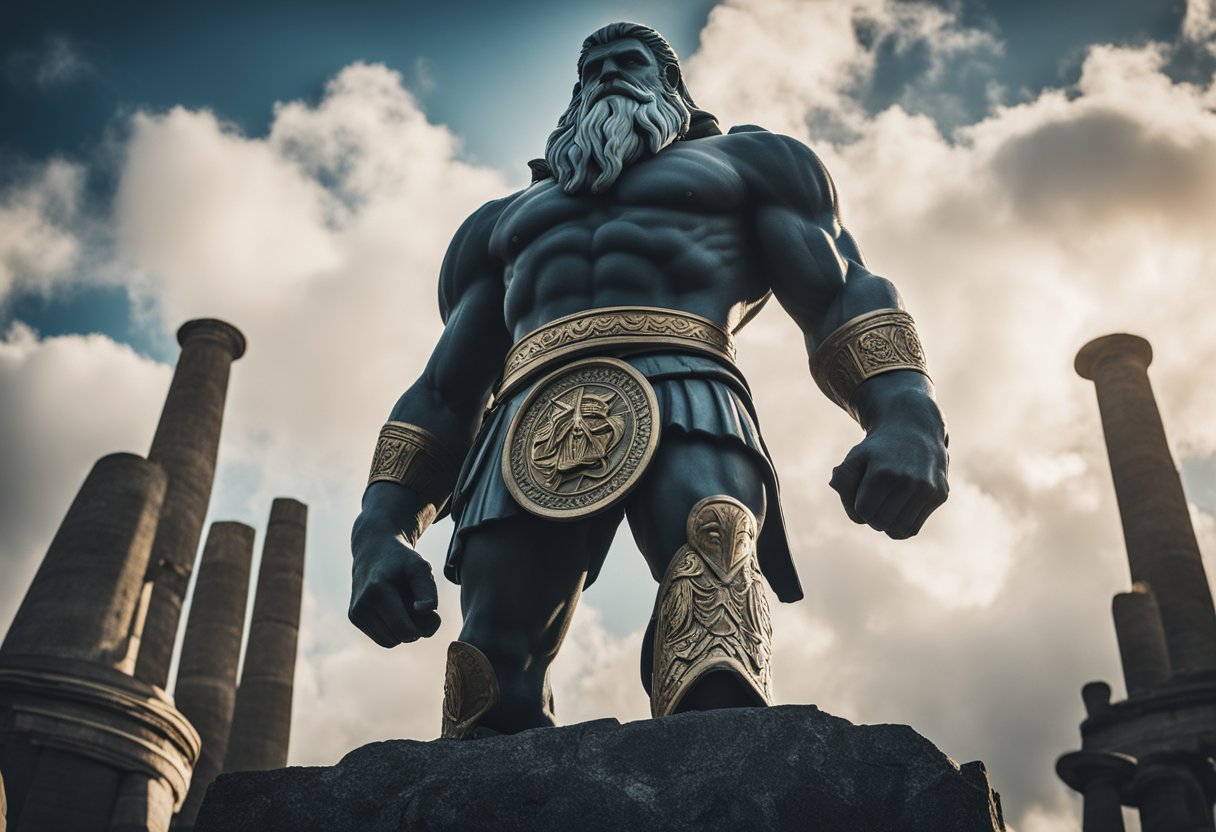
In this exploration, we travel from Greece’s Mount Olympus to the realms of Norse Asgard, exploring the epic conflicts and divine societies that shaped ancient mythologies.
Conflict in Greek Mythology: Titans vs Olympians
The Greeks painted a cosmos filled with divine conflicts, most notably the battle between the Titans and the Olympians. These ancient narratives, set against the backdrop of Greece’s towering mountains and sacred valleys, reflect more than mere rivalry; they encapsulate the transition of power from an older generation to a new pantheon of gods who made Mount Olympus their heavenly home.
The Aesir: Norse Gods and Their Realm
In the frostbitten realms of Norse mythology, the Aesir stood as the principal pantheon among the Asgardians. Asgard, often likened to a Norse version of Mount Olympus, was a fortified valley in the sky, housing gods such as Odin and Thor. This celestial domain, replete with its own heroic and divine dramas, was connected to Earth by Bifröst, a burning rainbow bridge.
Connections between Different Pantheons
The Greek and Norse mythologies, though distinct, share a common tapestry of divine conflict and heroic quests. Both cultures revered their gods who dwelt in lofty mountains or heavenly valleys, and both celebrated the deeds of legendary heroes. These connections highlight a universal theme across various cultures: the belief in a transcendent reality where gods shape the destinies of men.
The Titans: Elder Gods of Greece
Before the Olympian gods rose to power, the Titans were the pre-eminent deities of the Greek mythological world. Their narratives are rich with tales of power, betrayal, and a cosmic battle that would shape the future of the cosmos.
Titanomachy: The War of the Titans
The Titanomachy was the monumental conflict between the older gods, known as Titans, and their descendants, the Olympians. Zeus led his siblings and allies against the Titans, who were ruled by Cronos. This cataclysmic war lasted ten years and ended with the defeat of the Titans and their imprisonment in Tartarus.
Prominent Titans: Cronos, Atlas and Prometheus
Among the Titans, several stand out for their significant roles in Greek mythology. Cronos, the leader and the youngest of the first generation of Titans, is often recognised for usurping his father, Uranus and for his eventual downfall at the hands of his son, Zeus. Atlas, another notable Titan, was condemned to hold up the sky for eternity. Prometheus was known for his intelligence and for stealing fire from the gods to give to mankind, an act that led to severe punishment.
The Legacy of the Titans
The legacy of the Greek Titans is evident in their impact on the world order and in their progeny. Many Titans gave birth to other deities and creatures, leaving a lasting mark on Greek mythology’s complex pantheon. After the Titanomachy, the new order led by Zeus heralded the age of the Olympians, but the stories and myths surrounding the Titans continue to fascinate and serve as a foundation for understanding the ancient Greek worldview.
Across Cultures: Giants in Global Mythologies
Giants have loomed large in the mythologies of many cultures worldwide, embodying natural elements, moral lessons, and the essence of creation.
Japanese Oni and the Kubo Creation Myth
In Japanese folklore, the Oni are formidable ogres known for their fearsome strength and sometimes malevolent presence. These supernatural entities often play the role of villains in the tales but can also be protectors if respected, revealing the nuanced relationship humans have with these creatures of power. For the Kuba people of Central Africa, the creation myth speaks of Mbombo, a giant god who, through a process of vomiting forth the cosmos, brought into existence the sun, moon, stars, and earthly creatures.
Norse Jötunn and the Chinese Pangu
The Norse Jötunn are a race of beings comparable to the giants, including the famous Ymir, whose body was used to create the cosmos within Viking lore. These beings embody the untamed forces of nature and are often at odds with the Aesir, the pantheon of gods led by Odin. The Chinese myth of Pangu emerges from a cosmic egg and, with a mighty effort that costs him his life, separates the heavens from the earth to form the universe. Pangu’s actions and his gigantic form are at the heart of creation within this tradition.
The Intersection of Myth and Reality
In exploring the tapestry of human history, we often find a richly woven intersection where myth and reality coalesce, especially prominent in the legends of giants from diverse cultures.
Mythological Sites: Realms and Ruins
We navigate the landscapes of our earth, mindful that hills and valleys have long been the reputed abodes of mythological beings. From Ireland’s mythological cycle, extensive oral traditions speak of the Fomorians, mystical raiders believed to have inhabited the island. Today, these tales are etched into the very soil of places like the Giant’s Causeway, a UNESCO World Heritage site, where it’s easy to imagine giants striding across the ancient, hexagonal rocks stretching towards Scotland. Such sites provide tangible links to the myths that have permeated these locales for miles around, grounding flights of fantasy in the rugged reality of earth and stone.
Historical Kings and Mythical Giants
Kings of past centuries often donned the mantle of giants in posthumous tales, their real achievements infused with a layer of the mythical. This fusion is evident in the stories of the Milesians, legendary ancestors of the Irish, whose deeds echo the actions of historical kings through a veil of the extraordinary. The distinction between mortal kings and the giants of folklore gradually blurs, with both often attributed feats that define the character of the hills and valleys they ruled. These narratives, once part of oral traditions, offer insights into how communities viewed their leaders and their land, reinforcing the enduring presence of the faeries and giants of lore in the collective memory.
From Oral Traditions to Modern Interpretations
In exploring the evolution of myth, we find that the ancient tales once spoken have not only endured but have also found new incarnations in various forms of modern storytelling.
The Spread of Celtic Myths
Celtic myths have travelled from the echoing whispers of the oral tradition to find a new lease of life in written form. Surviving through the ages, stories like those of the Fomorians, giant-like figures infamous in Irish legend, have been anchored in the literary world after centuries of retelling by bards and storytellers. The transference of these narratives from the spoken word to the page secured their preservation, allowing them to become a cornerstone of folklore study and enthusiast circles.
Mythology in Contemporary Culture
The framework of these ancient myths has transformed as they permeated modern short fiction and genres such as science fiction and suspense. Flamboyant echoes of the giants of old can be seen in the creatures of the Flame Tree Gothic Fantasy series, where they’ve been reimagined to thrill and chill readers anew. By adapting and enriching these myths, contemporary culture sustains their relevance, enduringly fascinating us with their boundless possibilities.
We observe that myth is not a stagnant pool of the past but a river flowing into the future of collective imagination, where Celtic legends and the epics of other cultures continually inspire and shape the stories we create today.
Mythologies and Religion
In exploring ancient mythologies and their intersection with religion, we find that these stories were not just entertainment—they were foundational to cultural beliefs and identity. Our focus will navigate through the cultural metamorphosis during the Transition from Paganism to Christianity and the Influences of Myth on Religious Narratives, with specific attention to the entities of Christianity, pagans, Celts, myth, Tuatha Dé Danann, Greek mythology, and Celtic mythology.
Transition from Paganism to Christianity
Pagan belief systems, rich in deities and natural reverence, often gave way to monotheistic worldviews as Christianity spread. Celtic mythology, with its pantheon of gods like the Tuatha Dé Danann, experienced significant shifts in Ireland. As we embraced Christianity, saints often took on characteristics reminiscent of the pagan gods they replaced, blending traditions and smoothing the cultural transformation. For instance, Saint Patrick is credited with Christianising the Celts and is enveloped in legends that echo earlier mythic symbolism, like the banishing of snakes from Ireland.
Influences of Myth on Religious Narratives
Greek mythology, much like its Celtic counterpart, left an indelible mark on the religious stories that succeeded it. Figures such as the Titans resonated with tales from the Old Testament, where giant-like figures were woven into early Christian narratives. Myths, acting as symbolic preludes to religious texts, provided a framework upon which later religious narratives were built. Such stories contributed to the collective understanding of good, evil, chaos, and order—concepts central to philosophical and theological thought throughout the ages.
The legacy of these mythologies is still evident in contemporary societies’ values, symbols, and literature. By examining the transition and influences, we gain a richer understanding of our religious heritage and its roots in the myths that came before.
Giants in Literature and Art
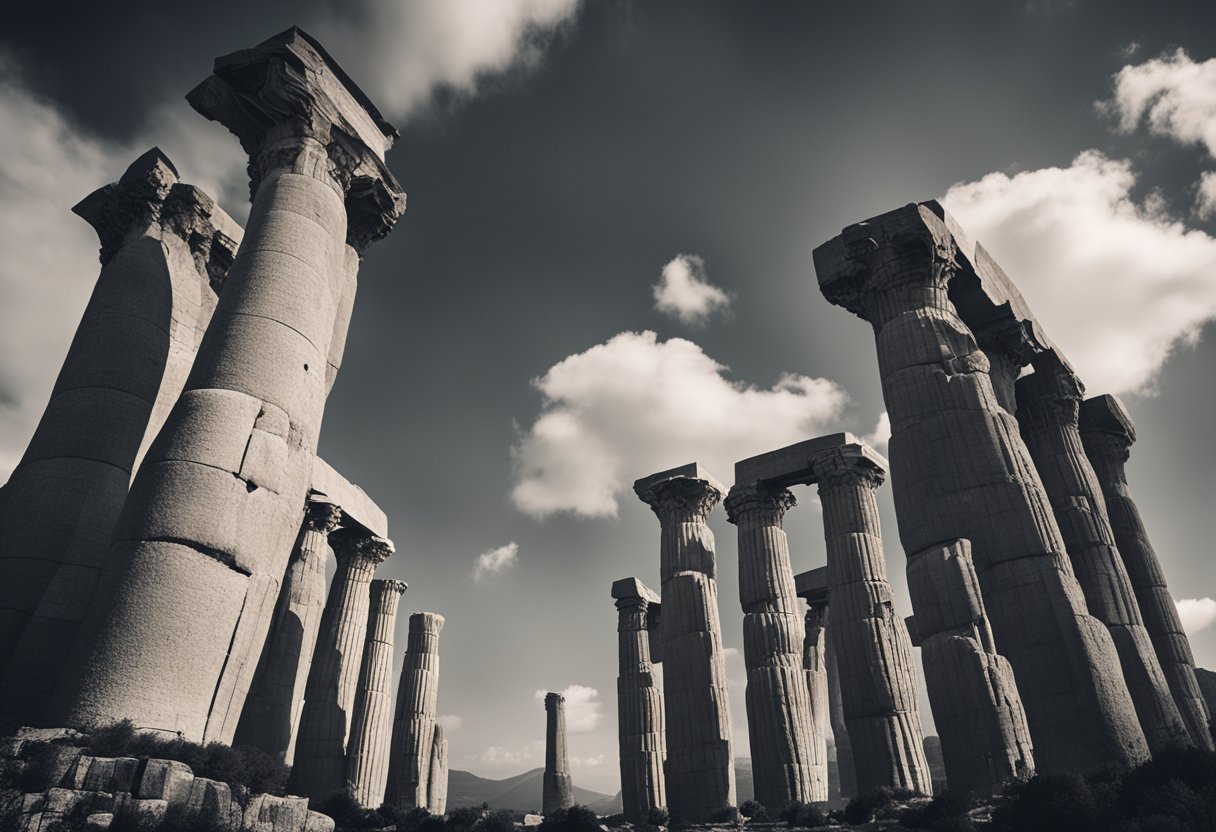
Giants have captured our collective imagination for centuries, manifesting in numerous cultural narratives where they often embody the battle between good and evil.
Epic Tales and Sagas
In the realm of literature, giants feature prominently in epic tales and sagas, intertwining with the fates of gods and mortals alike. The Mabinogion, a cornerstone of Welsh mythology, recounts tales of formidable giants who are as much a part of the landscape as the hills and valleys. Consider the figure of Ysbaddaden, a chief giant whose fate is intertwined with that of Culhwch in the quest for Olwen. Then there is the Anglo-Saxon Beowulf, one of the oldest surviving pieces of literature from the Early Middle Ages, where the hero confronts and vanquishes the giant-descended Grendel and his fearsome mother.
In Irish literature, the Cath Maige Tuired (The Battle of Mag Tuired) details the mighty Tuatha Dé Danann clashing with the Fomorians, malevolent giants representing chaos and wild nature. Such sagas are not just stories; they provide insight into the worldview and values of the cultures from which they emanate, immortalised in texts that have survived the ravages of time.
Mythical Representation in Visual Arts
The visual arts, spanning from classical sculpture to contemporary installations, have long depicted giants. Artists have harnessed their grand scale and metaphorical potential to evoke awe and moral lessons. Look at the works in the Flame Tree collections, where giants from myths stride alongside other legendary creatures, depicted with drama and details that kindle our imaginations. These representations often include giants, both fearsome and noble, encapsulating the ambivalence with which these beings are viewed within mythological frameworks.
Murals, tapestries, and paintings are visual literature, narrating stories where giants dominate landscapes, challenge the gods, and intervene in human affairs. Through these mediums, artists across the centuries have brought to life the larger-than-life figures of our oldest stories, ensuring that giants continue to loom large in our cultural consciousness.
The Influence of Myth on Modern Fantasy
Myths have woven their way into the very fabric of modern fantasy, lending their archaic strength to contemporary tales.
Gothic Fantasy and its Roots
Gothic fantasy, a genre steeped in atmosphere and melodrama, finds its bedrock in the ancient myths of Europe. This genre often exemplifies a marriage of mystery stories and classic stories—a tapestry woven with threads of the supernatural. Audiences are drawn to the dark labyrinths of gothic tales, where the aesthetics of medieval and Victorian settings evoke an intimate reading pleasure. Our fascination with the macabre in gothic fiction echoes the eerie lore found in myths where the unknown was filled with shadows and secrets.
Giants and Their Legacy in Recent Fiction
In recent fiction, giants uphold their mythic stature, serving both as formidable heroes and antagonists. This is evident in the Flame Tree Gothic Fantasy series, where the lore of titanic beings like the Fomorians influences plots, character archetypes, and world-building. These giants bring with them a sense of grandeur and scale, proving pivotal in how a narrative unfurls. The unfathomable power and presence of such creatures continue to captivate us, ensuring their role in modern short fiction is as colossal as their legend.
Frequently Asked Questions
In this section, we address some of the most intriguing queries about the giants of Irish and Greek mythology, focusing on the Fomorians and comparing them with the Titans of Greece.
Who were the most prominent giant figures in Irish mythology?
The most renowned giants of Irish mythology are the Fomorians, known for their strength and malevolence. They are often depicted as hostile and monstrous beings who come from under the sea or from other worlds to oppose the Irish deities, the Tuatha Dé Danann.
What is the origin story of the Fomorians in Celtic lore?
The origin of the Fomorians in Celtic myth is shrouded in mystery. They are said to have been one of the earliest inhabitants of Ireland, embodying the forces of chaos and wild nature against which the civilising Tuatha Dé Danann had to struggle.
Can you list the names of the Fomorian giants in Irish myths?
Key Fomorian figures in Irish legends include Balor of the Evil Eye, who could slay enemies with a glance, and Cichol Gricenchos, another formidable figure. These giants symbolise the darkness that predates the coming of the Tuatha Dé Danann.
How do the Fomorians relate to the Tuatha Dé Danann in Irish legend?
The Fomorians are often portrayed as adversaries to the Tuatha Dé Danann. Their conflicts, especially the notable battles of Mag Tuired, are central to Irish mythological narratives, symbolising the struggle between order and chaos.
What are the characteristics and stories associated with Balor in Irish mythology?
Balor is a key figure among the Fomorians, notorious for his destructive gaze. According to legends, he could lay waste to whole lands with his evil eye, and it was prophesied that he would be killed by his grandson, which came to pass at the hands of Lugh of the Tuatha Dé Danann.
In what ways do Greek Titan myths parallel the stories of the Irish Fomorians?
Both the Greek Titans and the Irish Fomorians are primordial giants associated with a preexisting order of gods. They are embroiled in epic struggles with a new pantheon of deities. Their tales represent the timeless themes of power, rebellion, and the cyclical nature of rule and resistance.


